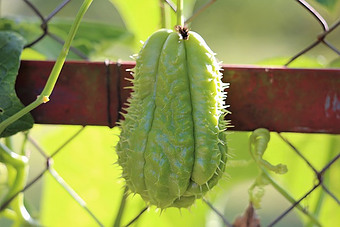Chayote is a pumpkin of an exceptional kind. It’s tender green and juicy, with a lemony touch of freshness. So try to grow chayote plant in your garden.
DESCRIPTION: Chayota – Sechium Edule
- Chayota is a vigorous and long climber that needs a lot of space and firm support.
- Its flesh is softer and juicier than zucchini, soft green in color, and has a delicate taste with a touch of lemon.
- Chayote leaves are similar in appearance to cucumbers but larger.
- Unlike other pumpkins, it does not hide seeds in its core but a stone.
- We know chayote with spines, but there are also some without spines.
- The fruits mostly weigh between 150 and 250 g, often even more.
ATTENTION: because of its spines, it is also known as a prickly pumpkin; because it is mainly grown in Mexico, you will find it in many nurseries under the name Mexican pumpkin.
How to Grow Chayote Plant
- For the chayote to give crop abundantly, it will need a lot of regular watering, as the chayote is a huge consumer of water.
- The chayote needs strong support, preferably metal, as it grows up to 10 or even 20 m.
- The better the quality and the more beautiful the fruits you choose for planting in autumn and storing in a cool place, the better the harvest next year.
- You always pick the fruits for planting in the fall and keep them wrapped in paper during the winter.
- The calyx sprouts at the end of winter, so chayote should be planted in a quality substrate at the latest in the second half of February.
ATTENTION: chayote is planted whole, so storing the seeds is unnecessary.
What Do You Have to Pay Attention to If You Grow Chayote Plant?
- Chayote is heat-demanding and sensitive to cold, so you must pay attention to the planting conditions and not plant too quickly, preferably in the second half of May, when you transplant tomatoes, peppers, cucumbers, and other fruit crops outdoors.
- You grow Chayote in pots for no more than 3 to 4 months, and the pot must be in a warm, heated room or greenhouse in a bright place.
- Because the Chayote needs support, tie the shoots to the support.
- Transplant the Chayote to a permanent place in the garden in the second half of May.
- The soil must be well fertilized, preferably with the organic fertilizer “neem seed meal,” which contains as much as 80% of the organic mass. At the same time, due to its insecticidal action, it prevents the presence of soil pests.
- Use mulch, as the soil must retain moisture well. You can help yourself with the zeolite flour, which loosens the soil and increases soil ventilation due to the soil’s formation of micro and macro pores. Since zeolite flour retains moisture and excess nitrates at the same time, there is no danger that the Chayote in your garden will not produce abundantly.
- Water, water, water; in the summer, water the Chayote well and soak it, preferably every day, with 10 L of water
- Chayote is a big consumer of potassium, which you have to add foliar by spraying for a tasty and rich crop. Use organic kelp fertilizer (seaweed with plenty of potassium, calcium, and amino acids) to reduce the shocks caused by the summer weather.
- The chayote fruit develops in 4 weeks.
- Individual plants produce up to 20 kg of fruit.
The formula for success: 1 ml Kelp tonic + 1 L lukewarm water; best to spray every 7 days.
How to Harvest Chayote?
- Harvest chayote only 3 to 4 months after planting.
- Use gloves as the fruit are full of sharp thorns.
Chayota in Cuisine
- ALL parts of the chayote are edible.
- Use the leaves as tea, as they reduce sugar and lower cholesterol.
- Use the leaves and flesh of the fruit in a smoothie because the meat is full of amino acids, vitamin C and B complex, and water, so it has a cleansing effect.
- The stone has a rich nutty flavor raw, but it is even better when fried, as it resembles a chestnut.
- The flesh of the chayote fruit can have a completely different taste, depending on the preparation method, as you can eat the chayote raw, stewed, baked, or fried!
- Due to the large amount of water, the fruits are also suitable for cold-pressed juices.
- The meat does not fall apart during cooking but needs at least 15 to 20 minutes of cooking.
- The flavors of chayote are reminiscent of: the taste of kohlrabi with lemon, and the stewed fruits taste similar to cauliflower.
- Chayote is useful for fillings, pies, wraps, omelets, compotes, and omelets.
- ATTENTION: Because the sharp spines of the chayote do not soften, the best way is to skewer the fruit on a fork, cut off the spines, and peel thoroughly.
